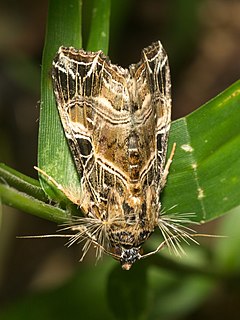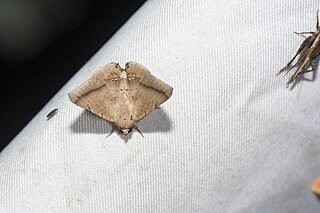
Cepora nerissa, the common gull, is a small to medium-sized butterfly of the family Pieridae, that is, the yellows and whites, which is native to Sri Lanka, India, China, southeast Asia, and Indonesia.

Leptotes plinius, the zebra blue or plumbago blue, is a species of blue butterfly (Lycaenidae) found in Sri Lanka, India to Australia. The species was first described by Johan Christian Fabricius in 1793.

Pachliopta jophon, the Ceylon rose or Sri Lankan rose, is a butterfly found in Sri Lanka that belongs to the swallowtail family. It was earlier classified as a subspecies of Pachliopta hector, the crimson rose.

Nephele hespera, the crepuscular hawkmoth, is a sphingid moth described by Johan Christian Fabricius in 1775.

Cethosia nietneri, the Tamil lacewing, is a species of nymphalid butterfly found in Sri Lanka and south India. The species name is after John Nietner who obtained specimens of the butterfly from Ceylon from which it was described.

Hippotion celerio, the vine hawk-moth or silver-striped hawk-moth, is a moth of the family Sphingidae. It was described by Carl Linnaeus in his 1758 10th edition of Systema Naturae.

Callopistria rivularis is a species of moth of the family Noctuidae. It is found from the Indo-Australian tropics of India, Sri Lanka up to the Solomon islands and Fiji.

Macaldenia palumba is a moth of the family Noctuidae first described by Achille Guenée in 1852. It is found from the Oriental region of India, Sri Lanka to Japan (Okinawa) and Sundaland, east to New Guinea. It is also found on Guam in Micronesia.

Asota caricae, the tropical tiger moth, is a species of noctuoid moth in the family Erebidae. It is found from the Indo-Australian tropics of India and Sri Lanka to Queensland and Vanuatu.

Asota ficus is a moth in the family Erebidae first described by Johan Christian Fabricius in 1775. It is found in Afghanistan, Bangladesh, China, Taiwan, India, Indonesia (Sumatra), Laos, Myanmar, Nepal, Pakistan, Sri Lanka, Thailand and northern Vietnam.

Acosmeryx shervillii, the dull forest hawkmoth, is a moth of the family Sphingidae. The species was first described by Jean Baptiste Boisduval in 1875. It is found from the Indian subregion, Sri Lanka, to Sundaland, the Philippines and Sulawesi. Acosmeryx pseudonaga is sometimes treated as a valid species.

Leucophlebia lineata, the large candy-striped hawkmoth, is a moth of the family Sphingidae. It was described by John O. Westwood in 1847. It is known from Sri Lanka, India, Nepal, Thailand, eastern and southern China, Taiwan, Cambodia, Vietnam, Malaysia, Indonesia and the Philippines. It is a minor pest of sugarcane.

Creatonotos gangis is a species of arctiine moth found in South East Asia and Australia. It was described by Carl Linnaeus in his 1763 Centuria Insectorum.

Ambulyx substrigilis, the dark-based gliding hawkmoth, is a species of moth of the family Sphingidae. It was described by John O. Westwood in 1847.

Ischyja manlia is a species of moth of the family Noctuidae first described by Pieter Cramer in 1776. It is found in the Indian subregion, Sri Lanka, Myanmar, Thailand, China, Okinawa, Sundaland, Sulawesi, Korea, the southern Moluccas, Australia (Queensland) and Palau. Adults pierce the skin of fruit to suck the juice.
Micraloa is a genus of moths in the family Erebidae from Hindustan, Himalayas, Sri Lanka and Myanmar (Burma).

Actinotia intermediata is a species of moth of the family Noctuidae. It is found in Asia, including India, Sri Lanka and Taiwan.
Palpifer taprobanus is a moth of the family Hepialidae. It was described by Frederic Moore in 1887 and is found in Sri Lanka.
Micraloa emittens is a moth of the family Erebidae. It was described by Francis Walker in 1855. It is found in India and Sri Lanka.
Creatonotos interrupta is a moth of the family Erebidae. It was described by Carl Linnaeus in his 1767 12th edition of Systema Naturae. It is often listed as a synonym of Creatonotos gangis, but the identity is unclear.















